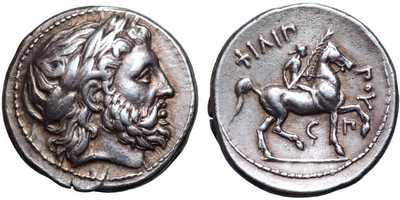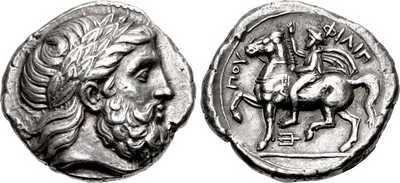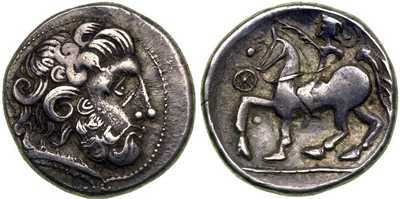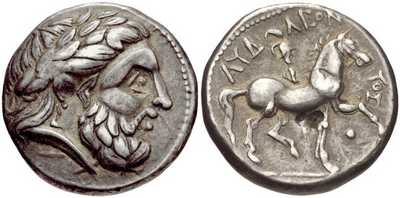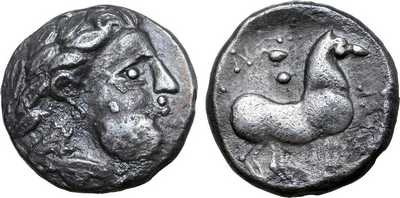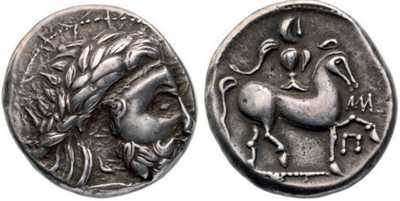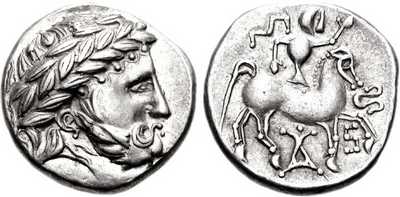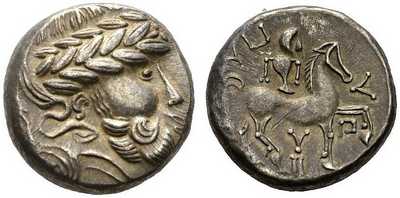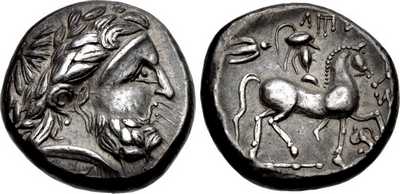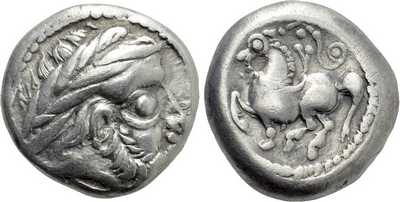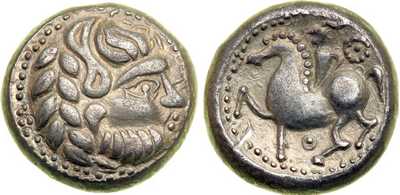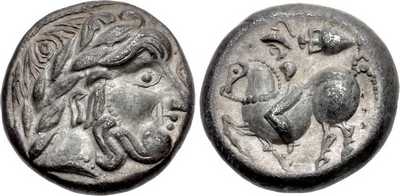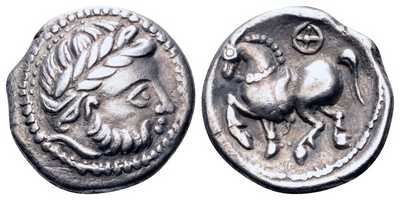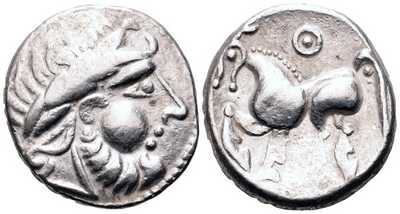| Back to Coins Derived from Thasos Tetradrachms | This page is part of the article Getting Started with Celtic Coins | Forward to Coins Derived from Alexander III and Philip III Tetradrachms |
The Eastern Celts minted many different types of coins derived from tetradrachms of Phillip II of Macedon.
Philip II “Youth Rider” tetradrachm (14.24g) Photo Copyright Roma Numismatics Ltd | Philip II “King Rider” tetradrachm (14.44g) Photo Copyright Classical Numismatic Group, LLC |
A small selection of the most commonly seen types are listed here in no particular order:
- Zweigarm (Branch Arm) Type
- Puppenreiter (Puppet Rider) Types
- Scordisci Types
Zweigarm (Branch Arm) Type
The Zweigarm (Branch Arm) type comes in two main sub-types. The first features a rider holding an arm out in salute, but that arm is actually a branch. In the second sub-type, the saluting arm is hidden behind the horses mane, but the rider now holds a branch up in their other hand.
Karl Pink named type 1 “mit ausgestrecktem arm” (with outstretched arm) and type 2 “mit zweig” (with branch) in his 1939 book “Münzprägung der Ostkelten und Ihrer Nachbarn”.
Photo Copyright Ira & Larry Goldberg
Photo Copyright Classical Numismatic Group, LLC
The Zweigarm type appears to have been inspired by the Philip II “Youth Rider” tetradrachm.
Readers of Karl Pink’s book may know that he classified these coins as deriving from the gold stater of Lysimachus. This is due to a tenuous similarity between the Horns of Ammon on Alexander’s head on those coins, and some locks of hair on these ones. If those locks of hair are put to one side, it’s clear that the actual inspiration for these coins was the two Philip II tetradrachms.
Puppenreiter (Puppet Rider)
The Puppenreiter (puppet rider) type describes a series of coins produced by the Pannonian Celts where the rider floats leglessly above the horse. These were initially derived from a tetradrachm of Philip II and coins from the Paeonian king Audoleon.
Photo Copyright Classical Numismatic Group, LLC (14.35g) |
Both the obverse and reverse are taken from the Phillip II tetradrachm, but the legend from the Audoleon coins is copied as well. This later becomes corrupted, but the Audoleon monogram is added below the horse. This too becomes corrupted, and then disappears.
There are eight types of coins in this series.
Audoleon Type
The first type is the “Audoleon type”, which features the legend “AYΔΩΛEON-TOΣ” which translates as “belonging to Audoleon”. This is taken straight from the Audoleon coins. A common feature of these coins is that most have a triskeles countermark.
Hochrelief Type
The second type is called the Hochrelief (high relief) type, where the depth of the image seems to have become more important than the details. It is during this type that the legend starts to disappear.
Puppenreiter Type
The third type is called the Puppenreiter (puppet rider) type and it is here that the rider takes on it’s distinctive floating form.
Audoleonmonogramm Type
The Audoleonmonogramm (Audoleon monogram) type has the remnants of the legend, but rendered in meaningless shapes. However, the engraver has added the monogram of king Audoleon under the horse.
Y auf Postament Type
The Y auf Postament (Y on Pedestal) type follows on from the Audoleon monogram type, but the monogram has now become corrupted, being replaced with a Y on top of a pedestal.
Mit Dreiecksornament Type
The Mit Dreiecksornament (With Triangular Ornament) type is another of the types where the legend is rendered in meaningless shapes. In this case, it is named after the distinctive triangles that appear above the rider where the legend was.
Triskeles Type
The Triskeles type is another of the types where the legend is rendered in meaningless shapes. In this case, it is named after the triskeles below the horse.
A feature that appears on some of these coins is that Zeus’s eye has an arrow head in it.
Dreizack und Triskeles Type
The Dreizack und Triskeles (Trident and Triskeles) type is another of the types where the legend is rendered in meaningless shapes. In this case, it is named after trident feature behind the rider, and the triskeles under the horse’s front leg. The “trident” is arguably a small flying figure.
Scordisci Types
The Scordisci tribe from present day Serbia minted a series of coins based on the Philip II tetradrachm with the king rider on the reverse.
These types are known as:
- Dachriter type
- Pegasos type
- Ornamentreiter type
- Kugelwange type
The Dachreiter and Kugelwange coins were struck in tetradrachm, drachm and obol denominations. It’s unknown if the Pegasos and Ornamentreiter types were also stuck in these denominations; they are rare coins and only tetradrachms seem to have been found. The Kugelwange coins are the most commonly available. The final versions were struck in billon and copper/brass.
Dachreiter Type
It’s not obvious why the name Dachreiter was given to these coins. Dachreiters (roof riders) are either small bell towers or figurines that sit on the ridgeline of buildings. There’s nothing in these coins that seems to meet this criterion. The obverse has a distinctive Zeus head, with a beard that leaves the cheeks and upper lip clean shaven. The reverse shows a fat prancing horse with a beaded mane and feathering on the lower legs. The head of the horse is also a distinctive shape.
On the tetradrachms, the rider wears an overly large S shaped hat. Over time, the tail of the hat forms a circle which eventually detaches.
When it does detach, it can either remain as a circle or transform into other shapes.
Drachms on the other hand appear to use a wheel in place of a rider, although interestingly the legs and feet of the rider are still present.
Pegasos Type
The Pegasos (Pegasus) type follows on from the Dachreiter type and is similar in appearance, the major difference being that the rider has changed into a set of wings for the horse. On early coins, such as this one, you can still see vestiges of the rider – the feet, part of thigh, and the reins.
Ornamentreiter Type
The Ornamentreiter (Ornament Rider) type also follows on from the Dachreiter type. Here, the rider is replaced with a large flower ornament.
Kugelwange Type
The final type in the series is the Kugelwange, or Ball Cheek, type. This is the most common of the types, and is characterised by the large ball like cheeks on the obverse. On the reverse, the rider has gone, replaced by a circle with pellet.
Further Reading
There isn’t much available in English about the coins of the Eastern Celts. The main reference books are in German, which makes them hard work if you don’t read German. The photos still provide excellent value, and you can learn a lot about individual coins types if you are prepared to spend time typing relevant sections into Google Translate. If you are serious about collecting this kind of Celtic coin then at least one of the following books is essential.
- “Ostkeltischer Typen Atlas” by Robert Göbl
- “Münzprägung der Ostkelten und Ihrer Nachbarn” by Karl Pink
- “Kelten im Osten. Gold und Silber der Kelten in Mittel und Osteuropa. Sammlung Lanz” by Michaela Kostial
“Catalogue of Celtic Coins in the British Museum. Silver Coins of the East Celts and Balkan Peoples. Volume I” by Derek Allen is in English, but it’s almost impossible to get and expensive when it does appear for sale.
“Coinage in the Celtic World” by Daphne Nash is in also in English, and is a great introduction to Celtic coins, including those of the Eastern celts. However, it doesn’t list all the different types like the books above do, and it only dedicates around 5 pages to the Eastern celts.
“Coins of the Ancient Celts” by Derek Allen and Daphne Nash is another book in English that covers these coins.
Article Navigation
| Back to Coins Derived from Thasos Tetradrachms | Up to The Eastern Celts | Forward to Coins Derived from Alexander III and Philip III Tetradrachms |
